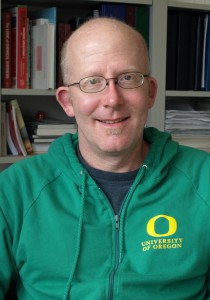

The University of Oregon Department of Chemistry and Biochemistry began the fall term with a new department head at the helm. On July 1, 2014, Andrew H. Marcus officially stepped up to the position as Michael Haley stepped down.
Professor Haley, of the department’s Organic/Inorganic division, served two 3-year terms as department head beginning in 2008, overseeing a period in which the number of our undergraduate majors nearly doubled and our graduate student enrollments increased 20%. Highlights of his tenure included the building of the new General Chemistry teaching laboratories and student Resource Center, overseeing two classroom remodels, more than doubling the number of teaching assistantships, and the hiring of six new faculty.
Professor Marcus, a Physical Chemist, was selected last spring by the department faculty and the College of Arts and Sciences to serve as the department’s next head. Prof. Marcus has been at the University of Oregon since 1996. This will be his first time serving as department head, and he is looking forward to working with colleagues to push the quality of the department even further.
Please join us as we welcome Andrew Marcus as our new head, and thank Michael Haley for his six years of service to the department!

